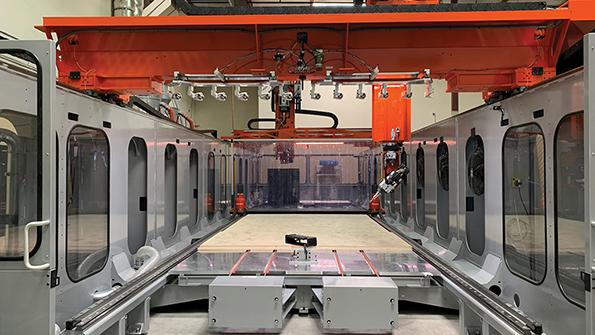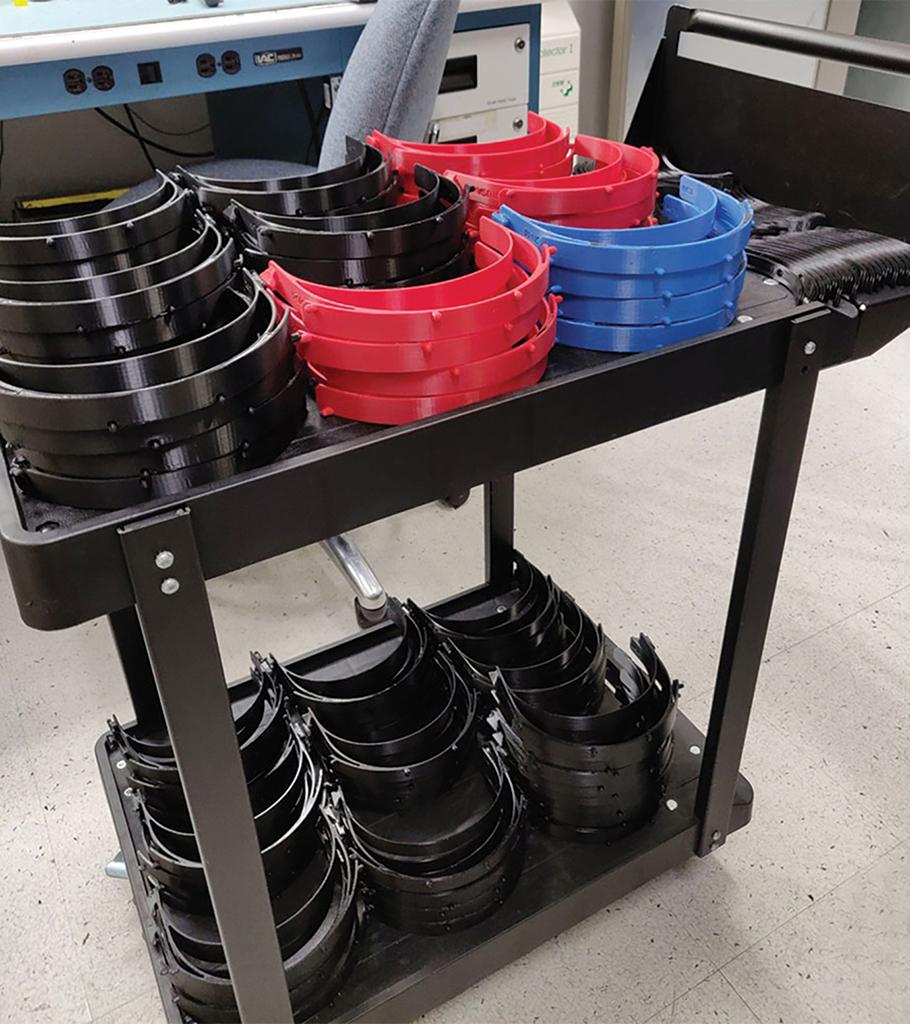
After decades of tinkering and years of major investments, aerospace and defense companies finally have found resonant missions for their 3D printers.
The catch: It is for personal protective equipment (PPE), the face masks and gear in strong demand following the COVID-19 outbreak, not for A&D products.
In April, Boeing announced it was activating its additive manufacturing (AM) network to create parts for face shields using 3D printing. The giant A&D company targeted an initial production rate of several thousand a week. Unionized workers donated overtime, and AM machines from St. Louis to Puget Sound in Washington to Huntington Beach, California, and Huntsville, Alabama, were engaged. Boeing’s advanced technology subsidiaries Argon ST and Aurora Flight Sciences also participated.
- 3D printing machines fall short, standards are unresolved, and training is missing
- The technology in A&D still could see 17% compound annual growth rate
Airbus and Raytheon Technologies, the other two leading A&D companies by annual revenue, announced similar efforts, with the latter engaging nearly 70 3D printers across its global locations to produce as many as 2,500 face shield headbands a week.
To be sure, the surge of 3D-printed PPE from A&D represents the sector pivoting to address an immediate public crisis. Yet A&D’s AM machinery has never been so universally marshaled, marking a climax for an advanced technology that has been decades in development but short of paradigm-shifting results inside industry. Why is that?
Like flying cars and orbital space tourism, 3D-printed aircraft have remained a distant goal passed from generation to generation. Now, as A&D enters a new phase of post-pandemic business conditions, AM evangelists are seeing both reason for optimism and sobering reminders why manufacturing in the sector has not fundamentally changed.
“You’ve got to have some hype to get to the point where someone says, ‘Yes, I’m going to buy $5 million of laser wire deposition equipment,’” says Laura Ely, a former leader of GKN Aerospace’s AM efforts who is now an industry advisor at the Barnes Group. “The problem that we have now is it’s so overhyped that it’s just, like, ‘stop.’ We don’t need any more evangelizing. We need people [who] understand how to get out of the trough.”
Ely and others point to the “Gartner hype curve” for AM in A&D, a chart produced by the eponymous consultancy and popular at industry conferences for the way it visualizes the adoption of 3D printing (see chart). Gartner in 2019 placed A&D AM near the bottom of a downslope entering the “trough of disillusionment.” It will take 5-10 years before 3D printing in A&D gets to the “plateau of productivity.”
“There are examples where the industry is more advanced than that, where people would definitely argue, ‘No, we’re walking up the slope of enlightenment. We’ve got our production factory, and we’re getting closer to that plateau of productivity,’” says Ely. “But that is more the exception than the norm. The examples are there, but it is definitely not something that would be true across the industry. That might represent the 5% that are playing in additive manufacturing.”
According to several interviews and reports, what is holding back A&D is its cultural rigidity—often a benefit in maintaining high safety levels but also a hindrance to innovation—as well as more corporate-level issues including insufficient personnel training and challenging business cases. There also are issues in matching 3D-printing realities to A&D needs.
It has been a long time in the making. The first technologies were in the 1980s, and the first metals and workflows came in the 1990s. But investment casting and sintering of green parts came only in 2006-10, when industry genuinely saw the first class of structural-grade output directly from 3D printers.
“Aerospace companies grasped the technology in the 1990s,” says Scott Killian, business development manager for aerospace at EOS, a provider of metal and polymer laser-sintering AM machines, materials and services. Killian has more than 25 years in the sector, dating to DTM, a forerunner provider. He recalls the excitement in industry after GE Aviation unveiled the 3D-printed Leap engine fuel nozzle in the early 2010s. “We really expected a lot of other people to kind of pile on with that,” he says. “And then, for lack of a better term, things seemed to stall a little bit.”

Juan Carlos Munguia Castaneda is engineering director at M Aerospace RTC and recently presented at the SAE AeroTech Digital Summit. He has a master’s degree in aerospace design with a focus on additive manufacturing and has worked for suppliers such as Collins Aerospace, now part of Raytheon Technologies. He and Ely note that there are still many limitations on the supply side of 3D printing.
“Equipment manufacturers are not quite hitting the bar of people’s expectations,” Ely says. “If you buy a standard CNC [machine], you have a set of expectations from really any supplier . . . that things will operate correctly, so we won’t have to do massive amounts of tweaking on it.
“With any of the major [A&D] manufacturers, you hear a story of a lemon that they got from them—every single one,” she continues. That becomes an issue because industry is looking for applications, not experiments. “I do feel that the general consumer, they’re past the point of ‘I’m just going to buy a machine just to play around with,” Ely adds.
There also are gaps in what is needed. “Unfortunately, even though there are a lot of companies trying to speed up and produce new powders, filaments and materials for additive manufacturing, we still have some limitations about which materials we have on the market,” Castaneda says.
At the same time, both Castaneda and Ely point to shortfalls in A&D practitioners applying AM. “If you don’t do an optimization of the part, you will have weight concerns,” Castaneda says. “It will use a lot of material instead of reducing the material you are using.”
Another compounding challenge is surface finishes. There are many efforts to improve the printing itself, but most of the time further finishing is required once it is out of the printer to get to final specs. This begets inconsistencies, the demon of quality control in replication.
“There are not a lot of industry standards yet for additive processes, and the aerospace business is all about standards,” Killian says. Related to that, “to get a part on an airplane from ground zero with additive manufacturing to actually fly is millions of dollars,” he notes, because certification is part-oriented.
But even as the machinery and business model remain challenges, human resources are a bigger issue. “There is a lot of lack of training—not a lot of people actually know how to use additive manufacturing,” Castaneda says.
Ely agrees. “What is the biggest thing that’s keeping AM from being used in a broader sense? The answer is people—-[they] are not broadly educated on additive manufacturing processes or how to design with them or use them in a manufacturing setting,” she says.
“Aerospace is what we call a risk-averse industry,” notes Patrick Dunne, vice president for advanced application development at 3D Systems and a longtime proponent for AM in A&D.
“What I do see generally is it is the fresh-out-of-college, inexperienced [folks who] have never been shouted at by design for manufacturing folks actually lead to iterations. . . . Folks who know what they’re doing would never have considered it in the first place,” he says. “Now we have folks that have grown up in a world where 3D printing has always existed. It’s not a novelty item anymore to them, it’s another tool in the toolbox.”
In her current advisory job, Ely says she encounters the same problem across industry. Clients say, “‘We bought a machine, it costs a lot of money; we’re kind of struggling a little bit, and we don’t really know what to do next.’ That is a really common one.”
The solutions, according to Ely, often are elementary: Have you plotted your qualification and certification plan? Have you gotten the machine calmed down and qualified?
Despite the frustrations, there is widespread agreement that AM’s role will continue to grow in A&D. The aerospace 3D-printing market was estimated at $1.86 billion in 2019 and is expected to grow at a compound annual growth rate (CAGR) of almost 17% over the next seven years to $6.72 billion in 2027. In January, market research companies Million Insights and Stratview Research separately said A&D will be a key customer propelling the greater 3D-printing industry this decade, with a CAGR of 34%.
Killian says the next five years will bring a dramatic pick-up in utilization. Interestingly, the coronavirus pandemic is not expected to have much of an effect on AM utilization. Part of that is because it still is not applicable to around 75% of A&D manufacturing, especially larger aircraft subsystems and flight-critical parts—and may not be for a long time to come.
“There are millions of parts out there [on which] you shouldn’t even be wasting time trying to put it in additive; you cannot get any benefit from it,” Killian says.
“Direct metal printing will really only be applicable for small, thin-wall, highly detailed components,” Dunnes notes. “That’s the reality, so [it would be] fuel injectors and small little brackets and stuff like that. It doesn’t make sense economically to use it for big parts. For indirect metals, which we class as investment casting, there are far better economics with investment casting and far more opportunities.”
Meanwhile, Ely and Killian point to the space sector, as the advent of a commercial low-Earth-orbit marketplace allows more from-scratch design and manufacturing. “The people who are really advancing in particular with additive manufacturing are people in the space arena, and part of that has to do with how mission-critical hardware is certified,” Ely says.
“There are not lots of volumes right now, so that means there are not a whole lot of machines out there building tons of rocket parts yet,” says Killian. “But it’s going to happen, and we’re pretty excited about it.”






Comments